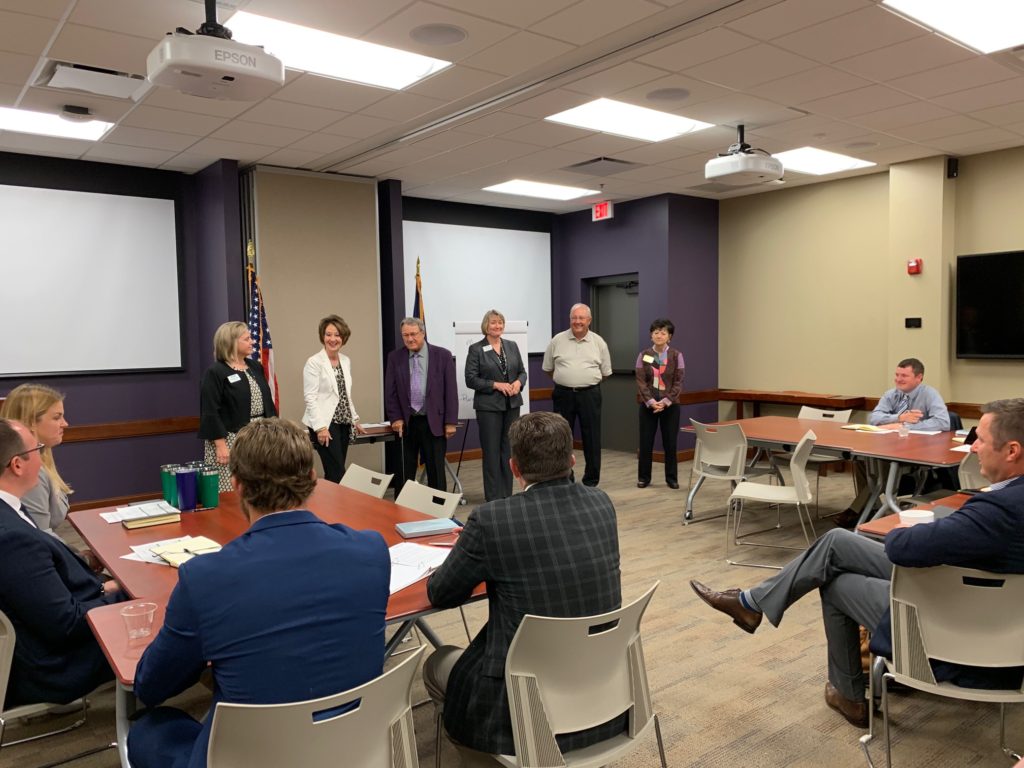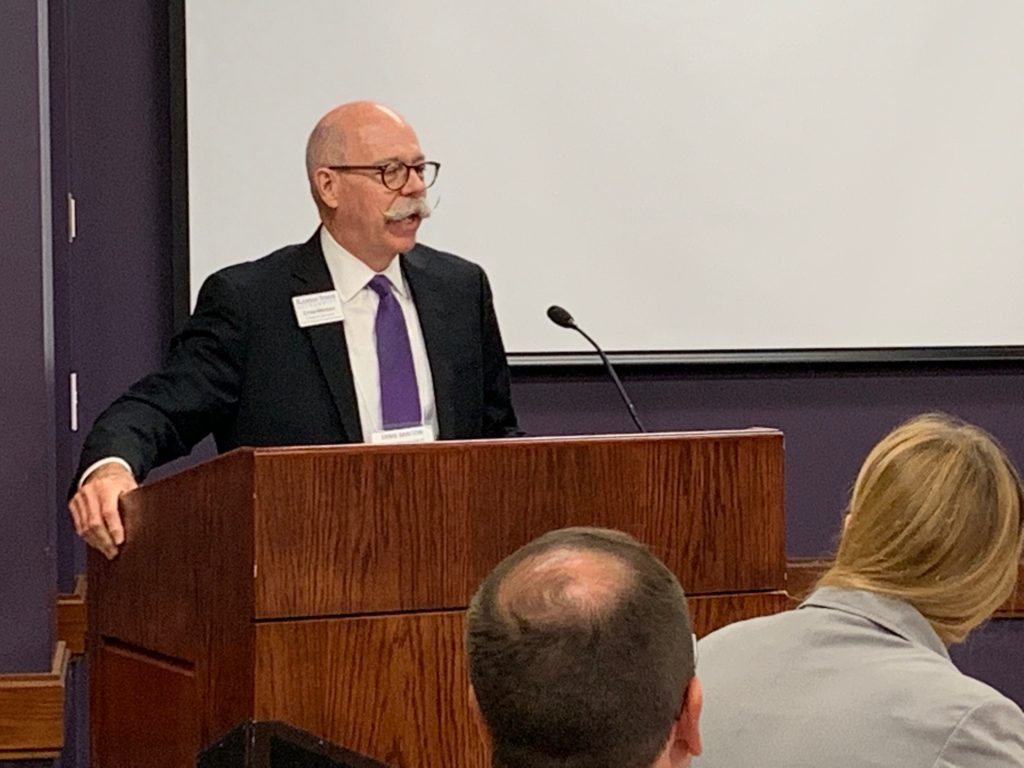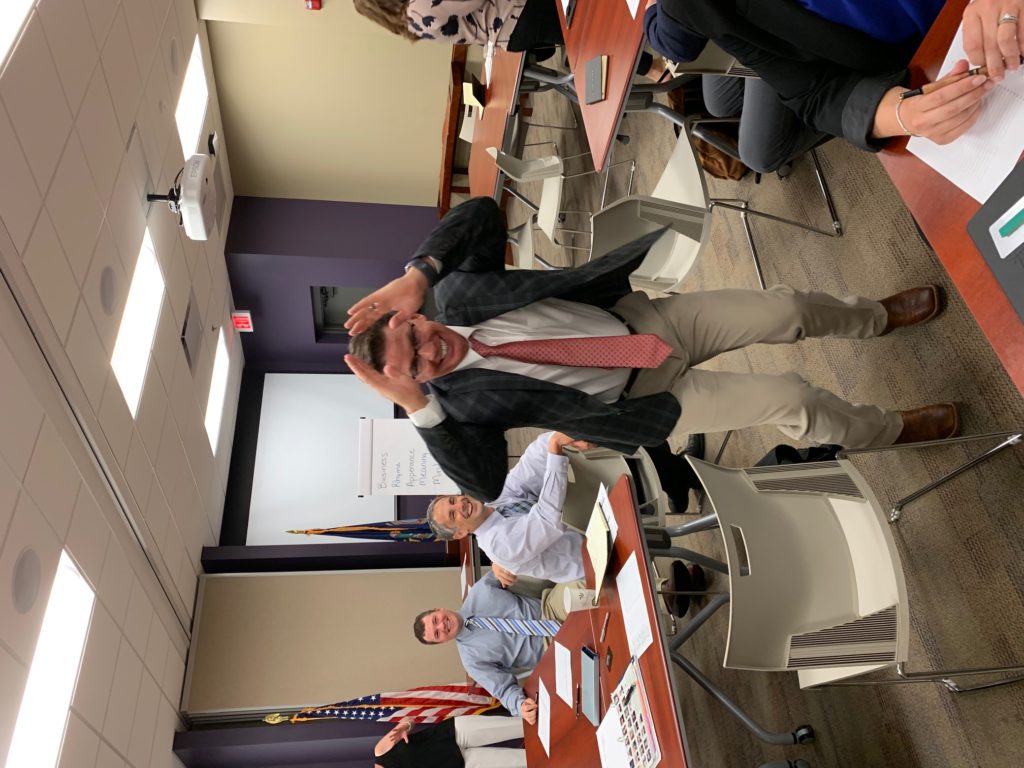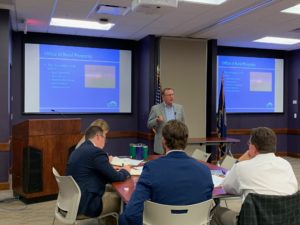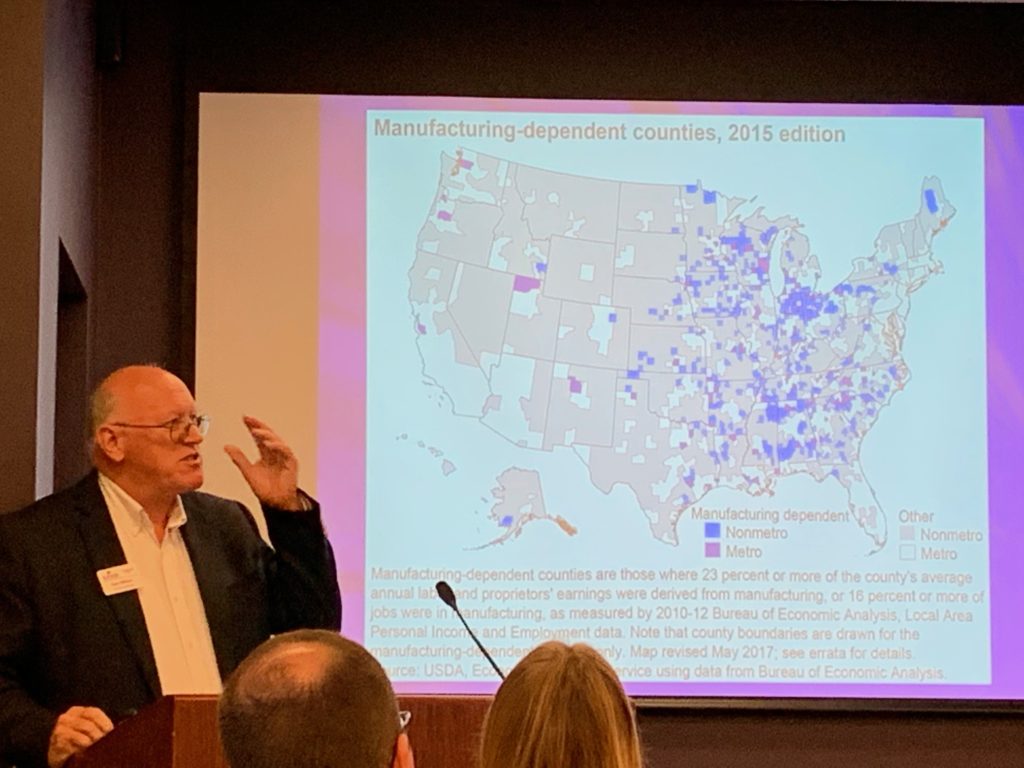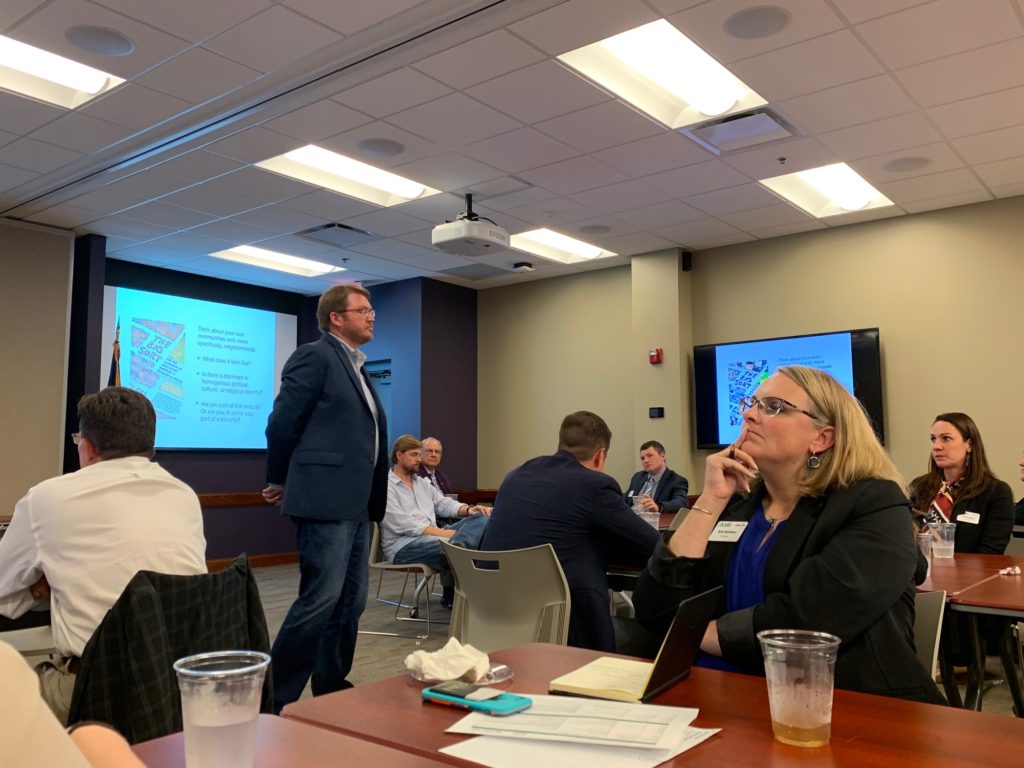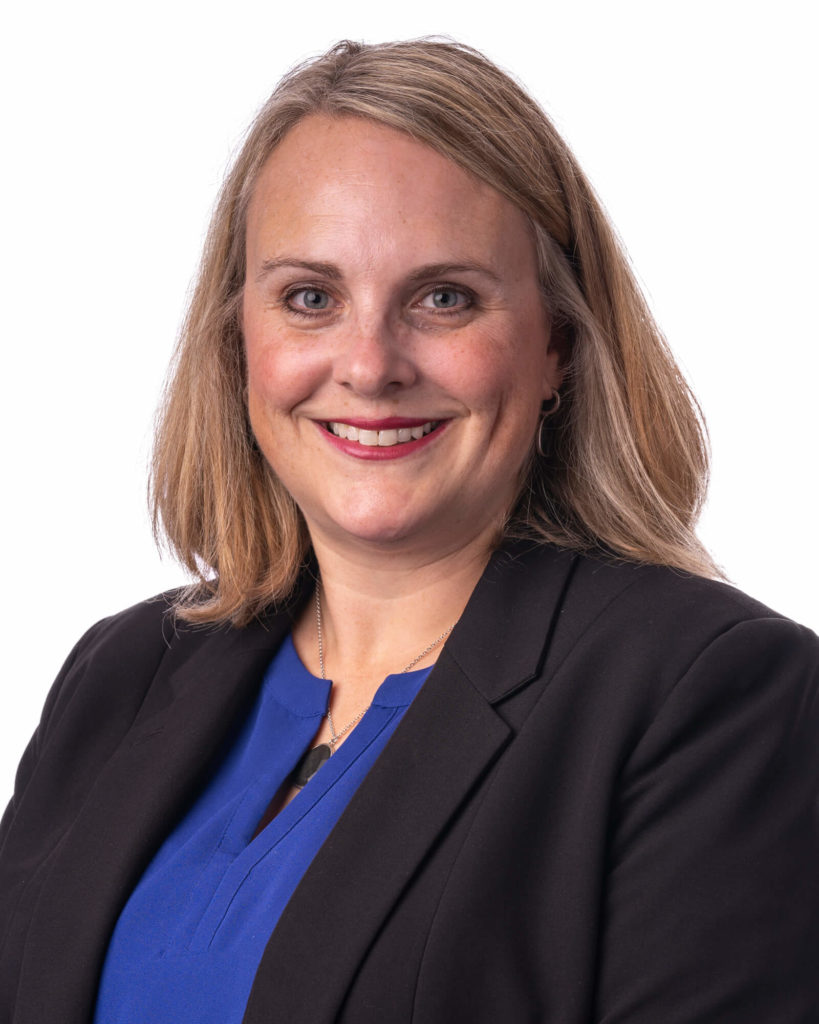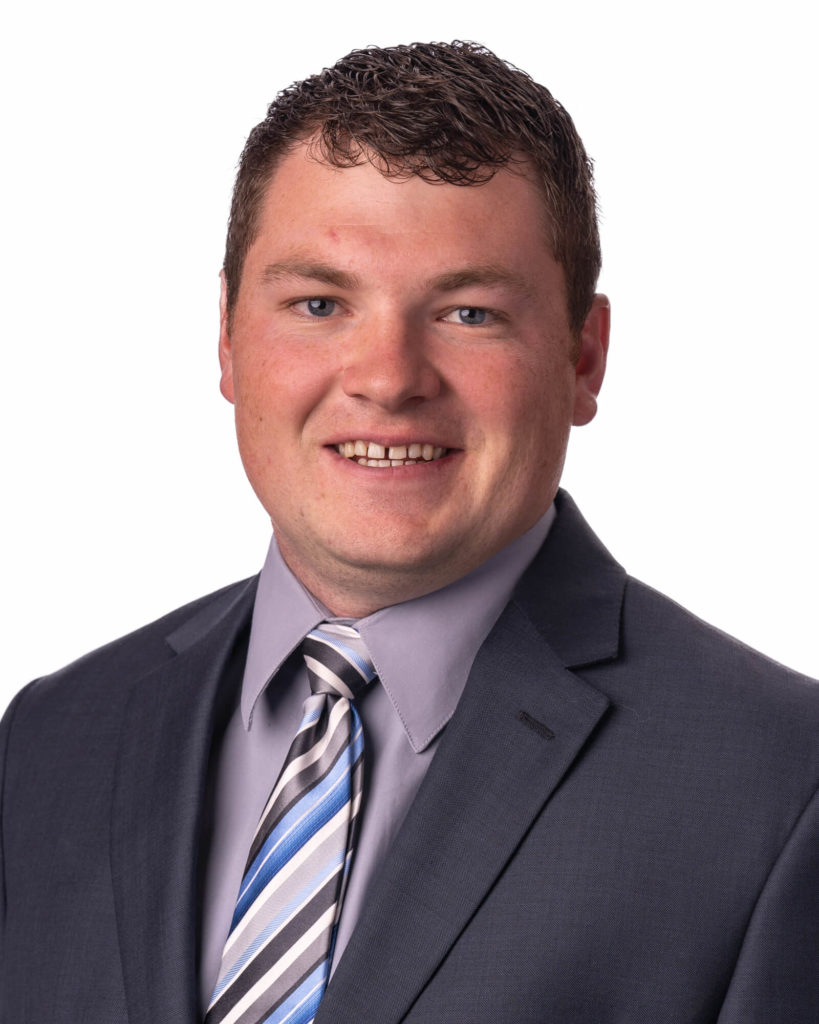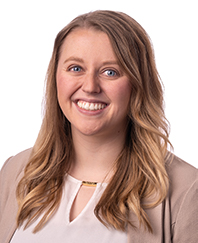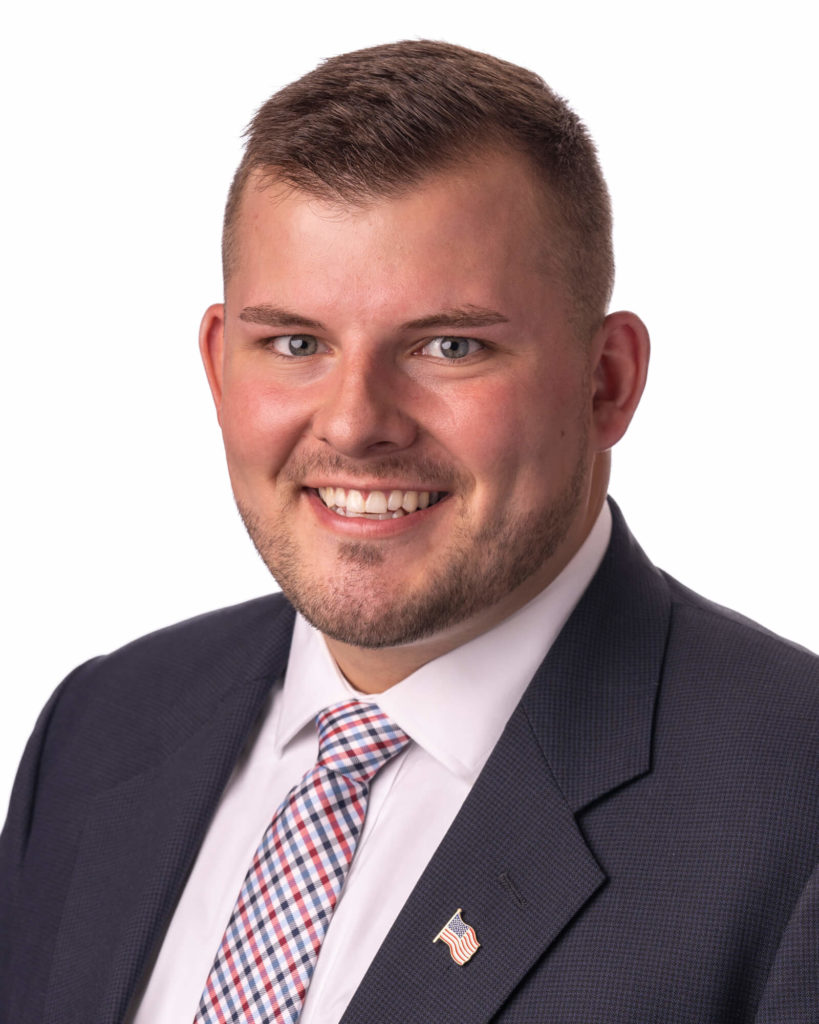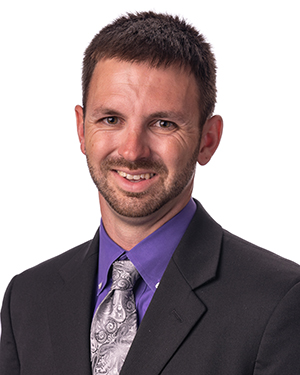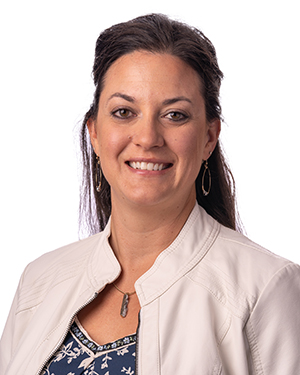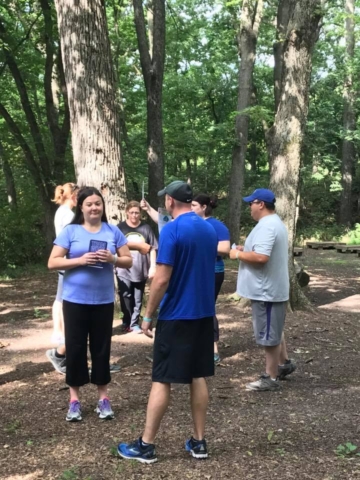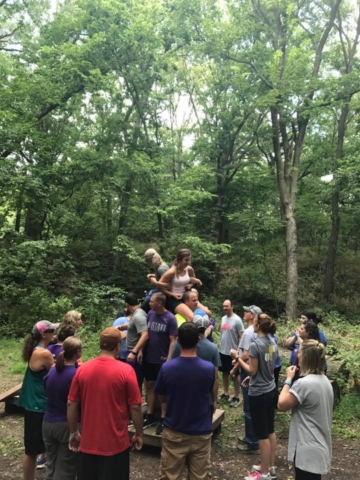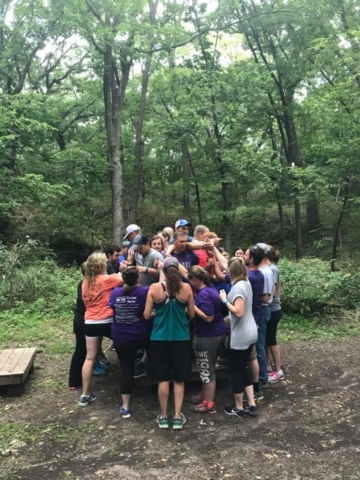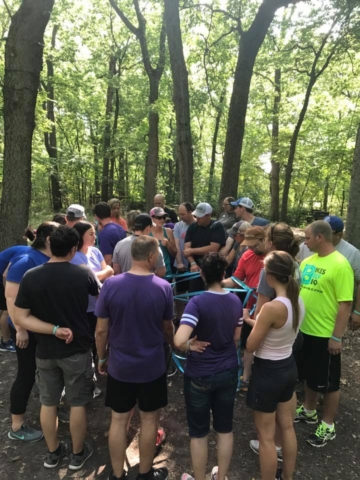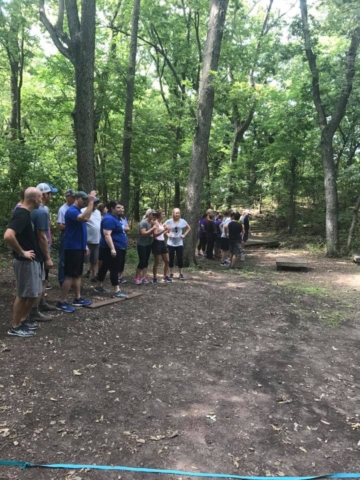Genesis Seminar – XV
Genesis Seminar
COMMUNICATION – TRUST – COOPERATION. Each critical components of leadership and a team. While at Rock Springs, KARL Class XV experienced the Leadership Adventure Course that reinforced these values.
KARL Class XV kicked off their Genesis Seminar which is just the beginning of their two-year journey. The seminar started at the Kansas Department of Agriculture with a Dale Carnegie of the Heartland seminar working with the Class to dive in and connect with others.
Genesis Day One
Thursday, August 22
Submitted by: Debra Tuefel
Our first official day as KARL Class XV began with an introduction from KARL Staff Susan Sankey & Jill Zimmerman. Their reminders of the impact this experience will have on our lives set the tone for the day as they reinforced the personal and professional investment we are making, and that others are making in us.
Our Chair for the day was Jackie Mundt, who introduced our speakers and added her personal flair to facilitating. We could see we are among the best of the best of Kansas leadership already.
It was an honor for past KARL Alumni to join us for the first session which included words of inspiration from Steve Baccus, Jerry McReynolds, Doug Hofbauer, Carolyn Harms, Mary McCurry and others who joined in later in the day. As Steve Baccus reminded us, “You are embarking on a journey that is going to impact your life. I promise you it will change your life.”
Next up we were welcomed to Manhattan by Dr. Ernie Minton, the Dean of Kansas State University College of Agriculture. He shared his perspective and some history of land grant universities. He reflected on the challenges our country is facing regarding trade policies and he acknowledged that Kansas has its own set of challenges. But he encouraged us to use this experience to make reasoned, well thought out decisions. As he reminded us, our country has adapted to challenges before – in 1862 when legislation was enacted to create the land grant system, when the Homestead Act and Transcontinental Railroad were enacted, in 1914 when the Extension System was created – all monumental milestones in the history of our country. His parting thought was to think about these monumental moments and translate that to the challenges we face today. “We’ve done it before, we can do it again”, as Dr. Minton encouraged us to use this opportunity as leaders to move us forward.
From this point, we dove right into a fun leadership exercise led by Dr. Amy Gross and Amanda Eilders, facilitators from the Dale Carnegie of Kansas. Their lessons from Dale Carnegie’s Golden Book were the foundation for leading us through an afternoon where we truly got to know our classmates on a whole new creative level. They encouraged us to make the choice to STEP IN and push our comfort zone. Get comfortable with the discomfort. Amy and Amanda helped us learn the value in making positive first impressions by being approachable, warm, professional and confident, but most of all memorable by using the pause/part/punch method to introduce ourselves. As we introduced ourselves in groups to the class, we practiced this method, and each shared what we are most looking forward to about KARL – our first introspective look at what motivates our peers in the year ahead. Next, we learned how conversation linking can help us remember details, and how to dig deeper and ask questions to develop better listening skills by driving the conversation.
The real fun began when we each got to develop our own “mind picture” of our name to help the class learn each and every name in the class. Needless to say, the most memorable “mind picture” agreed upon by all was Bob Temple. With a name like Bob….Temple….how could we forget? I’m not naming names but a few of us earned a 53/53 possible…not that there are any perfectionists in this Class XV.
Amy and Amanda left us with some parting words of wisdom. Principles from How to Win Friends and Influence People and they encouraged everyone to step outside of their comfort zone and DIVE IN!
After a short break and wishing Happy Birthday to our classmate, Kendra Riley, we dove right in at the Kansas Department of Agriculture with an introduction by Kansas Secretary of Agriculture, Mike Beam.
Secretary Beam gave an overview of the division within the Department and discussed their functions – Ag Marketing, Animal Health, Conservation, Water Resources, Agribusiness Services. A few statistics resonated with the group. The top 5 sectors by output in Kansas are beef cattle ranching, animal slaughtering, grain farming, pet food manufacturing, and meat processing. The total contribution of all 64 ag, food, and food processing sectors is $63.8 billion (a 5-year average), in addition to another $77.4 billion from food retail and ethanol. In 2017 Kansas ranked 5th of all states in Total value of Agricultural Production with $18.8 billion, led by California, Iowa, Texas and Nebraska. Kansas ranked 1st in sorghum production, 1st in winter wheat, 2nd in cropland, and 3rd in cattle. Some other striking statistics – The average age of a Kansas farmer is 58 years old, and only 10% of producers are 35 years or younger. Kansas ag exports have increased every year since 2015 to approximately $3.8 billion in 2018 with the top three destinations including Mexico, Japan, and Canada. Beef, wheat, and soybeans topped the list.
Secretary Beam shared some front-burner issues for the department including Kansas Industrial Hemp Research Program, Market Facilitation Program, Cattle Trace, the spread of Old World Bluestem and Emergency Planning for Animal Health, Office of Rural Prosperity, Strategic Growth, and Rural Broadband. In closing, Secretary Beam said, “These are stressful times.” There are many issues ahead to be addressed that impact Kansas agriculture and rural and ag families.
Our next speaker helped us take a deeper look at statistics about rural population trends in Kansas. Ron Wilson, Director off the Huck Boyd National Institute for Rural Development at Kansas State University is a highly recognized expert in the field of Rural Revitalization and Rural-preneurs. He tasked us to think about these statistics as if “You Are the Senator” and how we would address the rural population situation in Kansas. He shared national perspective on Economic Base industries – Farming, Mining, Manufacturing, Recreation and the counties which are most dependent on Federal/State government. He then shared population shifts occurring noting population density and what he called the “Hollowing Out the Middle”. There were notable shifts occurring beginning with major population shifts of rural decline in rural Kansas counties beginning in the 1950 Census forward. The most notable slide was a projection of Kansas counties which will decline between 2014-2044. Nearly 75% of Kansas counties are projected to decline over that period. From 2000-2010, 19 metropolitan counties added population equivalent to an Overland Park, while 86 non-metro counties lost the equivalent of Hays.
Next, Wilson discussed some rural development principles that can help support Ruralpreneuers and small-town quality of life including:
- Encourage regional grass-roots solutions
- Encourage value-added ag and local food access
- Maintain infrastructure – transportation, broadband, schools
- Enhance ag research and extension – innovation and education provide a rising tide that lifts all boats
- Build public-private partnerships and philanthropy (examples such as the Dane Hansen Foundation)
He encouraged us to think about what measures we would pursue so Kansans can thrive in the future. Some key takeaways – there is a “wave of wealth transfer coming” and a “greater separation between ownership and operation”. In closing, Wilson said “We need to celebrate, honor, value, promote Rural Kansas. We need to work at making it better, and if we do, the future will be in good hands.”
The closing speaker of the day was Dr. Timothy Shaffer, Assistant Professor, KSU Department of Communication Studies who speaks about the practice of deliberative democracy, civic education, and group communication. He gave examples of how we are wrestling with challenges that he called “wicked problems” currently in public dialogue. Some of these are cited in his book “A Crisis of Civility”. In the US, 93% agree we have a civility problem, 80% believe it leads to violence. He cited a report on Civility in America 2018: Partisan Agreement. 72% agree that civility has gotten worse compared to a few years ago, and Americans perceive political consequences to incivility include political gridlock. This comparison then looked at a historical perspective on civility, a view of crises that generations have experienced and how that leads to behavioral change.
Shaffer then talked about ways to encourage healthy civil discourse – debate, discussion, conversation, dialogue, and deliberation and a willingness to listen to others. We discussed the cultural and political backdrop and the politics before the “big sort”. Shaffer cited books that reference the change in association life in America – “The Vanishing Neighbor”, “Alienated America”, “Why the Garden Club Couldn’t Save Youngstown” and “Bowling Alone”. This Ecology of Democracy and how we think about communities, the impacts on news media, newspaper closures, and the polarizing viewpoints create a world where we have four Grand Challenges. 1) Lack of civil discourse due in large part to political and cultural polarization/separation. 2) Distrust of institutions and professions is increasingly common, especially with a degree of partisan difference. 3)Single narratives. 4)Divisive rhetoric, policy, and practices in response to shifts in demographics.
In closing, Shaffer shared a primer called Creating Space for Democracy and shared several tools that can help us in various group sizes and makeups to create constructive dialogue. He shared some deliberative dialogue examples used as early as 1935 that encourage group discussion models to revive civility. Tools are available at revivecivility.org, text Civility to 89800.
To wrap up the day, the KARL Class XV took a short journey down to Rock Springs Ranch where we checked in at the Leadership Lodge and prepared to refresh, reflect, and revive before we embarked on our continued journey the next day. If Genesis Day 1 was any indication of what lies ahead for this class, we are surely on our way to becoming better leaders to affect change in our communities, business, and lives in the two years ahead. Onward to Day 2!
Genesis Day Two
Friday, August 23
Submitted by: Kim Baldwin
Jim Wheaton, Executive Director at Rock Springs, visited with the class about the ranch’s history. The ranch was purchased in 1945 to be the home of 4-H Camp for all counties in Kansas. 4-H members and supporters of the 4-H program raised the funds to purchase the property paid off the mortgage within six months. To celebrate this accomplishment, they burned the mortgage in June of 1946 before the camping season began in July of 1946.
Currently, the ranch consists of approximately 750 acres and serves as a youth leadership training center while also hosting other guests including family reunions and corporate retreats.
The ranch’s major areas of focus include:
- Conservation—they are in the process of restoring 300 acres back to native grasses
- Center of Leadership
- Shooting Sports
- Equine
Following Mr. Wheaton’s presentation, Class XV members journeyed down the hill to the Riley-Wallace Educational Building. To begin the day, JJ Bebb (the Class Chair of the Day) facilitated a Day 1 review where class members provided two takeaways from the previous day. Class members’ takeaways included:
- Lessons from the Dale Carnegie presenters
- The importance of listening and key tools to use that were presented by Dale Carnegie staffers
- Energy on your face not just energizes you, but others you interact with
- The ability to get to know others by “diving in” and being genuinely interested in what people say
- Being open to allowing yourself to be vulnerable
- Strategies to use to get involved and spur conversation
- Strategies to use in order to keep conversations going
- Carnegie Principles (Always trying to understand the other side)
- First impressions of KARL and the KARL Class XV
- Awkward is awesome
- The overall diversity represented within this new KARL class
- Overall representation of ag and rural within this class
- The power of the Board member and KARL alum testimonies
- Thoughts on Ron Wilson’s presentation
- Population maps and the issues of population decline within areas of Kansas
- What is happening to scare off industry?
- What’s happening with the rural/urban split?
- The ability to take off the state/national solutions hat and think local action
- The overall extent of the population shift
- Definitions of “rural” change and the recognition that successful urban was at one time rural
- The age scales impacting rural populations
- 10% of farmers under age of 35
- Dr. Shaffer’s Civil Discourse and its Implications presentation
- Ecosystems of Communities
- How can we pull neighbors into conversations
- Conversation vs. debate vs. discourse
- How Extension facilitated discourse in 1900s
- Where can we create the bowling leagues
Following the class’s Day 1 review and discussion, the class made its way to the Leadership Adventure Course where the group worked together on a number of activities that helped illustrate the importance of communication, problem solving, listening to others, blindly trusting one another, and at times utilizing grit and muscle to overcome obstacles (like a giant wall).
The class enjoyed a nice lunch at Williams Dining Hall before returning to Riley-Wallace Educational Building to meet with Cathy McClain, CEO of Dauntless Leadership. McClain spoke on the Hands, Head, Heart- Being a Courageous Leader. She shared her experience of being a pilot and flying into a war zone. She discussed how as leaders, we make decisions without all information while leading your people.
Hands—Technical Skills (Analyzing and making decisions)
Head—Judgement on the job and in leading (charting a path)
Heart—Believing in the importance and worthiness of one’s contributions (Foundational beliefs about purposes)
For courageous leadership, one must start with heart.
McClain explained that one’s leadership presence is so powerful because a leader’s state of mind is contagious. According to McClain, most employees say their organization’s climate can be traced to the action of one person—the leader.
McClain also spoke about the “Amygdala Hijack” where a situation causes your amygdala to hijack control of your response to stress. The amygdala disables the frontal lobes and activates the fight-or-flight response which leads to an emotional response—the opposite of a calm, resilient, clear headed leader.
McClain suggested that in order to “reset” the following technique should be utilized, thus, bringing stress levels down:
- Gratitude
- Slow, measured breathing
- 5 seconds in, 5 seconds out
- Repeat 3 times
Following McClain, three representatives from Kansas Department of Agriculture spoke on initiatives and critical issues for KDA.
Lane Letourneau, Water Appropriation Program Manager within the Division of Water Resources, discussed water rights in Kansas. Letourneau shared that Kansas is a 1st in time, 1st in right state (since 1945). He discussed permit types and requirements within Kansas. He also identified major groundwater sources in Kansas and the Groundwater Management Districts (GMDs) in Kansas. He also explained Local Enhanced Management Areas (LEMAs) as proactive plans developed by locals and GMDs. Letourneau discussed a water management tool that allows for more flexible solutions taking into account the area and aquifer known as Intensive Groundwater Use Control Areas (IGUCAs). Letourneau also shared a map of Kansas reflecting the annual water usage. Much of that usage is used for irrigation, with smaller areas utilizing water for industrial, municipal, stock and recreation.
Justin Smith, Deputy Animal Health Commissioner, spoke on animal traceability within the state. Kansas is considered progressive regarding traceability. Cattle Track is currently in its second year. Additionally, KDA is continually working to secure food supply systems by helping build individual biosecurity plans for individual operations. Currently, 95% of Kansas facilities have an enhanced biosecurity plan. Smith also discussed how a disease for one species could also impact other areas. Smith discussed how the African Swine Fever could negatively impact the beef industry and also cause a $4-5 billion loss within the corn industry. Smith discussed how Kansas is the tenth in the nation for swine productions and is considered an import state. Being an “import state” increases vulnerability and exposure to livestock diseases. KDA has participated in Foreign Animal Disease Diagnostic workups for the last 25-30 years in Kansas, and KDA practices an annual foreign animal disease exercise.
Kerry Wefald, Agriculture Marketing Director, navigated the KARL class through some key items and information that can be found on the KDA website. Wefald also discussed the estimated economic impact of agriculture, food, and food processing sectors. Currently, there are 64 sectors in Kansas that have a total direct output of approximately $46.4 billion and support 125, 411 jobs in Kansas. Wefald shared the impressive increase in dairy exports following the introduction of a dairy processing facility where dry milk powder is exported to 16 countries and accounted for $48.8 million in sales in 2018. Wefald also shared how KDA works to match Kansas counties to potential growth opportunities through KDS’s Strategic Growth Initiative. This initiative allows counties to voluntarily identify the areas of the food, agriculture and unmanned aerial systems (UAS)/small aircraft industry in which they would like to grow. These growth areas are then aligned with the state’s strategic growth plans for 19 sectors across Kansas. Wefald also discussed international marketing and trade statistics for Kansas. In 2018, the top Kansas ag export product was meat (edible offal) and accounted for 44.2% of all Kansas ag exports (more than $1.6 billion in 2018). Kansas continues to export to a number of countries, however, 32.74% of 218 Kansas exports went to Mexico (approximately $1.2 billion in 2018).
Following a short break, Sarah Farlee (Class XII) spoke to the class about creating our own 150-word bios and six-word memoirs. Farlee will use the information collected to share on social media and other promotional material as well as sharing profiles in annual reporting.
KARL staff Jill Zimmerman and Susan Sankey followed Farlee to discuss how to get the most out of each KARL seminar. Leadership roles and expectations were discussed. Topics including dress code expectations, utilization of name badges, punctuality, usage of technology, identifying Alpha Mates, the act of writing thank you notes, and alcohol use were all covered. Additionally, KARL class members were encouraged to post and share of social media channels, using the hashtag #KARLXV.
KARL class members were then excused to prepare to leave for Kniebel Cattle Company where Kniebel Cattle Co., Downey Ranch, and Ginger Kopfer sponsored a dinner and social. KARL alumni shared their reflections and beliefs in the KARL program. Trevor McKeeman, Ken Woods and Sara Dawson spoke on a panel to share how their KARL experiences have impacted their lives and businesses prior to KARL Class XV members returning to Rock Springs for the evening.
Genesis Day Three
Saturday, August 24
Submitted by: Garrett Reiss
We started off the day with a reflection of everyone’s key take away from the day before. What stood out to me was all the different points and epiphanies that people found. There was not much overlap and it was very good to hear everyone’s point of view. A key point was the impact that the dry milk facility has had in Kansas and how this was a result of a vision from over 30 years prior. Another key takeaway was that Cathy with Dauntless Leadership shared a way to lessen your adrenaline and get back to logical thinking and away from emotions. The last thing that multiple people shared was about perspective and how KARL helps you broaden your vision and see the other side. The best part of this session was seeing the comfort level of the group change from the prior day. You could clearly see the level of conversation getting deeper and the closeness of the group increased immensely just over a couple of short days.
In our next session, we heard from Steve Baccus and Doug Hofbauer. They gave us some insight into what to try and get out of the KARL program and what the next two years have in store for us. Steve said he was impressed with the class members’ perspectives and our ability to share them. He also noted that we seemed to build great cohesion between the class. He remembered a KARL ad that he saw a long time ago and it said KARL would broaden your horizon and he feels that this is still true today. Doug noted that he was envious of the opportunity that the class has as he was never in the KARL program but now serves on the board. In a question and answer session with Steve and Doug they voiced that the vision for KARL has stayed the same in their opinion, but the inner workings of the class have changed over time with a shift in the culture to push the outer limits and challenge status quo more than in the past.
Lastly, we finished with Jill and Susan talking to the class about expectations, goal setting, standards, and mentoring. In this session, we watch a video of Mike Krzyzewski about leadership. Mike stated that a leader’s goal is to put people in a position to win and create a culture of success. The most important thing a leader can do is engage with people, listen, and always tell the truth. Every great team must have trust, if a team has trust then the team acts like one.
Challenges for Class XV
- Steve challenged us to take advantage of the opportunity before us and let it shape the rest of our lives.
- Jancy Hall, from last year’s class, challenged us to be a super-inclusive class and truly connect to each person in the class as we all can learn from one another.
- Susan challenged us to open up and connect with our classmates and to push our comfort zone.

